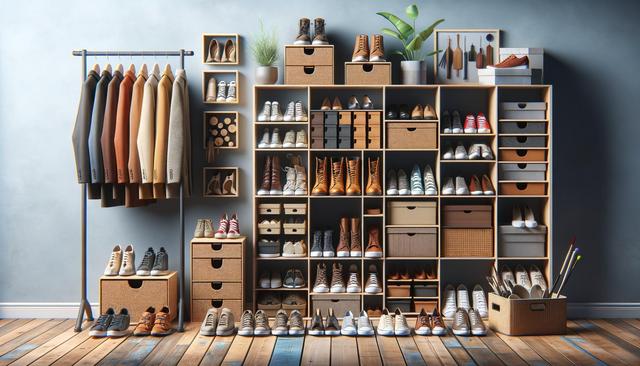Assessing Your Shoe Collection
Before diving into organizing strategies, it’s essential to evaluate your shoe collection. Many people hold onto shoes they no longer wear or need, contributing to unnecessary clutter. Start by taking out all your shoes and sorting them into categories such as work, casual, athletic, and formal. This step helps you understand how much storage space you’ll need and highlights any duplicates or worn-out pairs that could be donated or discarded.
Once sorted, ask yourself a few key questions:
- Have I worn this pair in the last year?
- Do they still fit and feel comfortable?
- Are they in good condition, or do they need repair?
Being realistic about your needs will free up space and make your organization efforts more effective. After you’ve narrowed down your collection, you can plan your storage system accordingly, focusing on what matters most: accessibility and space efficiency.
Making the Most of Vertical Space
One of the most overlooked areas for shoe storage is vertical space. Many people focus only on floor-level solutions, which can limit your storage potential. Utilizing vertical space helps keep shoes off the floor, prevents clutter, and maximizes your room’s overall layout. Wall-mounted shoe racks, over-the-door organizers, and tall shelving units are all excellent options for creating a more organized shoe area.
Here are a few vertical storage ideas to consider:
- Install floating shelves to stack shoes in an aesthetically pleasing manner.
- Use an over-the-door shoe organizer to store flats, sandals, or lightweight shoes.
- Invest in a tall cabinet with adjustable shelves for more versatile storage.
Vertical solutions are particularly useful in small apartments or homes with limited closet space. When combined with clear labeling or transparent storage bins, they also enhance visibility, making it easier to find the pair you need at a glance.
Creative Storage Solutions for Small Spaces
Living in a compact area doesn’t mean you have to sacrifice organization. Small-space dwellers can benefit from multi-functional furniture and hidden storage hacks that keep shoes out of sight but easy to access. Think beyond traditional shoe racks and explore creative storage options that blend seamlessly with your existing decor.
Some creative ideas include:
- Under-bed storage bins or rolling drawers for seasonal shoes.
- Storage ottomans that double as seating and discreet shoe containers.
- Clear stackable boxes that fit under furniture or in narrow closets.
These solutions allow you to store shoes efficiently while maintaining a clean and clutter-free environment. They are particularly helpful for people who live in shared spaces or have limited access to closet storage. Prioritizing compact, multi-use solutions can significantly enhance your organization strategy without requiring major renovations or investments.
Establishing a Shoe Rotation System
One key to staying organized is implementing a rotation system that highlights your most frequently worn shoes while storing less-used pairs. This approach not only makes daily access easier but also helps preserve the condition of shoes that are only worn occasionally. Seasonal rotations are especially practical, allowing you to keep boots accessible in winter and sandals front-and-center in summer.
Here’s how to set up a rotation system:
- Designate a primary storage area for shoes you wear weekly.
- Use labeled boxes or bins to store off-season or special-occasion shoes elsewhere.
- Set a reminder to reevaluate your rotation every few months.
By rotating your shoes, you reduce wear and tear on your favorites and keep your storage areas from becoming overcrowded. This system is also helpful for families with multiple members, ensuring that everyone has easy access to their everyday shoes while maintaining a tidy space.
Maintaining Your Organized System
Once you’ve set up your shoe organization, the next challenge is maintaining it. Even the most efficient system can fall apart without regular upkeep. Establishing simple habits will help you keep your shoe area neat and functional over time. For example, make it a routine to put shoes back in their designated spots after use and do a quick check every few weeks to ensure everything remains in order.
Helpful maintenance habits include:
- Doing a monthly cleanup to remove dirt and check for damage.
- Reassessing your shoe needs seasonally to avoid clutter buildup.
- Encouraging household members to follow the same system.
By staying consistent, you’ll enjoy a more organized home and save time during your daily routine. A well-maintained shoe system not only improves the look of your space but also extends the lifespan of your footwear by keeping them clean and properly stored.
Conclusion
Effective shoe organization can bring clarity and convenience to your daily life, especially in homes where space is at a premium. By assessing your collection, utilizing vertical and hidden storage, and maintaining a simple rotation system, you’ll create a more functional and visually appealing living space. Whether you’re working with a spacious closet or a compact apartment, these hacks can help you stay organized and make the most out of every square inch.






